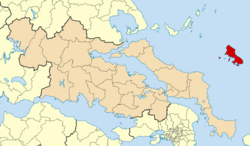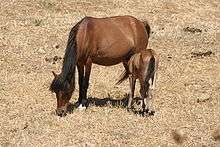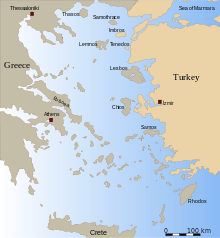Skyros
| Skyros Σκύρος | |
|---|---|
|
Chora | |
 Skyros Location within the region  | |
| Coordinates: 38°53′N 24°31′E / 38.883°N 24.517°ECoordinates: 38°53′N 24°31′E / 38.883°N 24.517°E | |
| Country | Greece |
| Administrative region | Central Greece |
| Regional unit | Euboea |
| Area | |
| • Municipality | 223.10 km2 (86.14 sq mi) |
| Highest elevation | 792 m (2,598 ft) |
| Lowest elevation | 0 m (0 ft) |
| Population (2011)[1] | |
| • Municipality | 2,994 |
| • Municipality density | 13/km2 (35/sq mi) |
| Time zone | UTC+2 (EET) |
| • Summer (DST) | UTC+3 (EEST) |
| Postal code | 340 07 |
| Area code(s) | 22x0 |
| Vehicle registration | ΧΑ |
Skyros (Greek: Σκύρος) is an island in Greece, the southernmost of the Sporades, an archipelago in the Aegean Sea. Around the 2nd millennium BC and slightly later, the island was known as The Island of the Magnetes where the Magnetes used to live and later Pelasgia and Dolopia and later Skyros. At 209 square kilometres (81 sq mi) it is the largest island of the Sporades, and has a population of about 3,000 (in 2011). It is part of the regional unit of Euboea.
The Hellenic Air Force has a major base in Skyros, because of the island's strategic location in the middle of the Aegean.
Municipality
The municipality Skyros is part of the regional unit of Euboea.[2] Apart from the island Skyros it consists of the small inhabited island of Skyropoula and a few smaller uninhabited islands. The total area of the municipality is 223.10 square kilometres (86 sq mi).[3]
Geography

The north of the island is covered by a forest, while the south, dominated by the highest mountain, called Kochila, (792 m), is bare and rocky. The island's capital is also called Skyros (or, locally, Chora). The main port, on the west coast, is Linaria. The island has a castle (the kastro) that dates from the Venetian occupation (13th to 15th centuries), a Byzantine monastery (the Monastery of Saint George), the grave of English poet Rupert Brooke in an olive grove by the road leading to Tris Boukes harbour. There are many beaches on the coast. The island has its own breed of Skyrian ponies.
History
According to Greek mythology, Theseus died on Skyros when he was thrown from a cliff by the local king Lycomedes. The island is also famous in the myths as the place from where Achilles set sail for Troy after having been discovered in the court of Lycomedes by Odysseus. Neoptolemus, son of Achilles, was from Skyros (or Scyros, as its name is sometimes transliterated), as told in the play by Sophocles, Philoctetes (line 239). There is a small bay named Achili on the east coast of the island that is said to be the place from where Achilles left with the Greeks, or rather when Achilles landed there during a squall that befell the Greek fleet following an abortive initial expedition landing astray in Mysia.[4]
In c. 475 BC,according to Thucydides (1.98), Cimon defeated the Dolopians (the original inhabitants) and conquered the entire island. From that date, it was colonized by Athenian settlers and became a part of the Athenian Empire. It was on the strategic trade route from Athens to the Black Sea. Cimon claimed to have found the remains of Theseus, and returned them to Athens.
In 340 BC the Macedonians took over the island and dominated it until 192 BC, when the king Philip and the Roman Republican forces restored it to Athens.
After the Fourth Crusade, the island became part of the domain of Geremia Ghisi.
Rupert Brooke, the famous English poet, is buried on Skyros, having died on board a French hospital ship moored off the island in 1915, during World War I.[5] Present at the at Brooke’s burial, on 23 April 1915, were Patrick Shaw-Stewart and William Denis Browne.[6]
In 1941, Pulitzer Prize winning poet Karl Shapiro wrote the World War II poem Scyros, which he set on the island Skyros "because it was a tribute to and irony upon Rupert Brooke."[7]
In 1963, the Archaeological Museum of Skyros was established in 1963, with the inauguration taking place 10 years later in 1973. The Faltaits Folklore Museum was founded in 1964 and was one of the first local folklore museums to operate in Greece.[8]
Historical population
| Year | Population |
|---|---|
| 1981 | 2,757 |
| 1991 | 1,806 |
| 2001 | 2,602 |
| 2011 | 2,994 |
Transportation
Air travel
Skyros is home to the Skyros Island National Airport, a one-runway airport.
Sea travel
Skyros Shipping Company operates the ferry service to Skyros. During holiday season the ferry runs twice daily from Kymi to Linaria on Skyros. During the winter months the service operates daily.[9]
Gallery
References
| Wikimedia Commons has media related to Skyros. |
- ↑ "Απογραφή Πληθυσμού - Κατοικιών 2011. ΜΟΝΙΜΟΣ Πληθυσμός" (in Greek). Hellenic Statistical Authority.
- ↑ Kallikratis law Greece Ministry of Interior (in Greek)
- ↑ "Population & housing census 2001 (incl. area and average elevation)" (PDF) (in Greek). National Statistical Service of Greece.
- ↑ See scholia (bT) ad Iliad 9.326 for the latter story and the harbor's name.
- ↑ "Archived copy". Archived from the original on 2010-04-05. Retrieved 2010-01-02.
- ↑ Blevins, Pamela (2000). "William Denis Browne (1888–1915)". Musicweb International. Retrieved 9 November 2007.
- ↑ Shapiro, Karl (1988–1990). Poet : an autobiography in three parts. The Younger Son. Algonquin Books of Chapel Hill. p. 119. ISBN 0912697865. OCLC 17651234.
- ↑ "Guide to the island of Skyros".
- ↑ http://www.greekisland.co.uk/skyros/skyros.htm Greek Island Holidays





